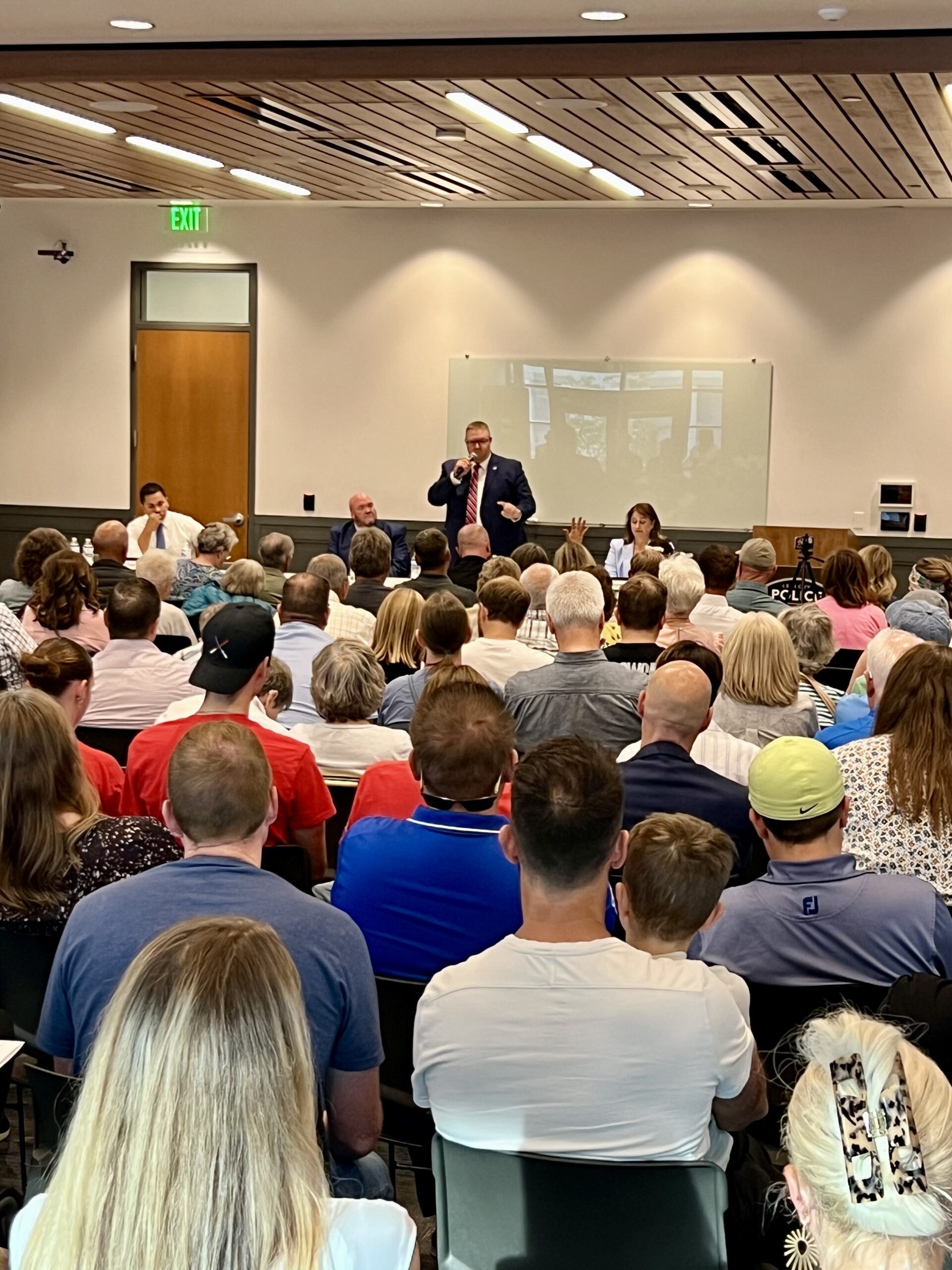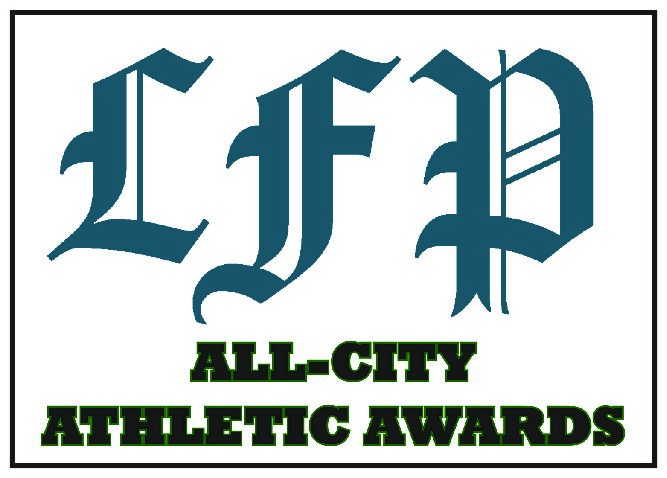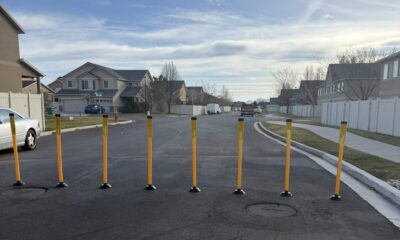Politics & Government
Debate coverage: Mayoral candidates face questions focused on land development, traffic
Published
5 months agoon

Matt Hemmert | Lehi Free Press
All candidates for Lehi City Mayor and City Council discussed issues in a question-and-answer session hosted by the Lehi Free Press and the Point of the Mountain Chamber of Commerce last Thursday evening. Dr. Greg Jackson moderated the debates and explained that the topics he chose were representative of questions collected through public input and the Lehi Free Press editorial board.
Candidate answers are summarized, and some questions and answers are omitted due to space limitations. However, the debates may be viewed in their entirety on the Lehi Free Press Facebook page.
The Mayoral candidate debate began with a question about the Lehi General Plan: what are the top three aspects, strengths, and weaknesses, and what would address any weaknesses?
Current Lehi City Councilor Paige Albrecht stated that major issues with incompatible abutting zones were primarily addressed in the city’s 2022 General Plan update. However, she continued, the problem persists in some areas, and solutions like enhanced buffering requirements should be considered. Albrecht said that the strength of the General Plan lies in its interplay with master transportation, infrastructure, park, and revitalization plans as the city’s needs evolve. In listing another strength, Albrecht noted that the General Plan is now easier to work with, which has led to a decrease in the number of General Plan amendment applications.
Paul Binns began by saying that, by examining the General Plan, we need to consider where the city is headed. In the past 15 years, Binns noted that Lehi has grown from 47,000 to 95,000 residents “due to zoning changes,” and the city must adhere to these laws. Binns stated that zoning laws are primarily designed to protect health, safety, and welfare. Property owners, he said, have property rights granted by the US Constitution; however, the city shouldn’t just rezone for others who want to come to the city. Safety, he said, is key to zoning and the need to keep our families safe.
Chris Condie, who is currently on the Lehi City Council, said that it’s important to recognize that the General Plan is easily susceptible to change, given that it simply takes a majority of the City Council to vote to amend it. He continued by stating that it is essential for a mayor to understand the issues that come before the City Council to effectively guide and persuade the City Council to make decisions that are best for the city. Condie further stated that a mayor’s success is dependent on their ability to define a vision for the city and effectively work with the City Council to implement that vision.
Charlie Tuatuaa began by saying that the General Plan relies heavily on working with federal and state agencies, which can be difficult. He continued by stating that the city should be advocating for light rail to divert to either the east or the west instead of bringing traffic directly through Lehi. Tuatuaa further noted that city leaders should increase the involvement of residents in the development of a city’s master plan to foster better community engagement and create personal connections that enhance the success of a plan or project.
Mayoral candidates were asked about their views on the 2026 Lehi City budget, specifically what they would like to see changed, if anything.
Albrecht explained that the 2026 budget is smaller than the 2025 budget due to a decrease in the number of capital projects. In addition to funding general improvements in the city. Albrecht said that the city was also able to hire three additional parks employees, three additional police officers and a code enforcement officer. Regarding the change, she explained that she participated in the decision not to spend $800,000 on a permanent ice rink and had maxed out the rainy-day fund, as per the state allowance. She noted that property tax hikes have been minimal and pointed out that city costs increase just as our costs rise with inflation.
Binns did not address the 2026 city budget directly, but pointed to his 25 years of business experience working with budgets. Binns said that the city has done okay with budgeting, but that there are holes. He stated that the police department has not grown in proportion to the population growth. Binns further stated that budgets can consider both needs and wants, but emphasized that needs should be met correctly and appropriately before addressing anything else. Binns also said he would rely on close coordination with city staff to understand their needs.
Condie said that in the 2026 city budget, an additional $6.5 million was allocated to the rainy-day fund, which represents 35% of the city’s general fund and the maximum allowed under state law. He said he would like to see this reduced to 30% of the general fund due to the need to fund both one-time and ongoing expenses. He also noted that current funding for the police department isn’t allocated without coordination with the police chief to ensure that what is being allocated is appropriate; he stated that, on average, the city funds three additional police officers per year.
Tuatuaa also did not address the city’s 2026 budget directly. Instead, he offered that instead of the $1.7 million [sic] allocated to new police officers, the city should use $500,000 as bonuses to attract officers from other cities to live in Lehi. Drawing on his experience in law enforcement, he stated that having more police vehicles stationed in residential areas serves as a crime deterrent and also adds a layer of voluntary response to Lehi’s law enforcement needs. Tuatuaa also recommended that a satellite police station in southeast Lehi could help with response times and presence. He also suggested cutting employment benefits for the city council and mayor.
The mayoral candidates were asked about Lehi’s transportation infrastructure challenges, which fall under the purview of UDOT. From roads to light rail, how would you work with UDOT to advocate for our city’s priorities, and with whom would you collaborate?
Albrecht said that in 2018, Lehi hired an engineering firm to provide the city with more accurate data than UDOT was using and providing to Lehi, and that Lehi has been better situated to advocate for improved planning. She also said that Lehi meets with neighboring cities every quarter to discuss local and regional transportation needs and plans. In addressing the future, Albrecht stated that Lehi will see an increase of 60,000 trips daily, with a projected population increase of 600,000 to the west. Lehi has to be prepared, she continued, and that means offering solutions that don’t include taking homes and businesses in Lehi to widen Pioneer Crossing, such as advocating for a north shore freeway option. She added that Utah Congressmen Owens and Curtis have submitted requests for federal funding to study the feasibility of such options so that decisions can be based on data. To address Binn’s comment that Lehi needs an increased meeting cadence rather than quarterly, Abrecht said she plans to create a traffic task force.
Binns stated that the backyard of his home abuts Pioneer Crossing and that no additional land was saved for expansion when it was built. “There have been fifteen years of planning and fifteen years of associated inaction,” he added. Binns said that it’s incumbent on a mayor to lead a collaborative effort, and that such efforts need to happen more than once a quarter. Binns said he would work with both county and state representatives to address Lehi issues and also stressed the need for action now, as Lehi doesn’t have time to wait for UDOT completion dates, such as the proposed timeline of 2028 for 2100 North.
Condie said he would work directly with other local officials and state legislators, and wanted to remove politics from the way of solutions. He said that cities to the west will have different opinions about solutions and that Lehi has to plan for its east-west traffic to get to and from I-15. There is more that can be done with other routes, he continued, like Redwood Road and Mountain View Corridor, and perhaps a new connector north of Lehi. He also said he’d encourage engineers to workwith engineers, administrators to work with administrators, and politicians to work with politicians, and let the professionals present real solutions to decision-makers.
Tuatuaa responded that we’re putting money into roads now while the future looms, and that merely expanding roads doesn’t provide solutions when the future arrives. He also questioned why Lehi needs to spend time and money planning and developing infrastructure for other cities, stating that American Fork, Highland, and Alpine can take their own roads and connect to Draper, and that Saratoga Springs and Eagle Mountain can expand Redwood Road. He said that Lehi is being impacted by CO2 and noise pollution, and shouldn’t pay for other cities’ problems.

You may like
-


Pioneer girls drop three to tough teams in hoops
-


Give a piece of Lehi from the Lehi Historical Society gift shop
-


Students, Jazz Bear team up for annual holiday shopping event
-


The Ruth’s “Charlie and the Chocolate Factory” a whimsical treat
-


Lehi Free Press
-


UCHD confirms new measles case in Utah County
-


Barriers near 2100 West cause confusion for Lehi residents
-


Lehi to host national hoops showcase
-


Pioneer boys begin with tough schedule
-


Falcon boys make promising start

